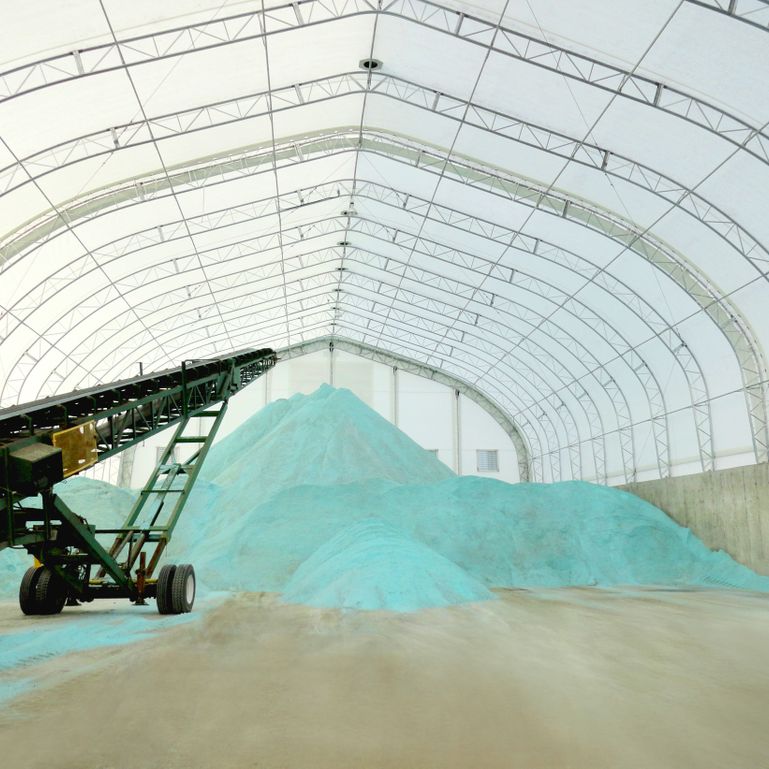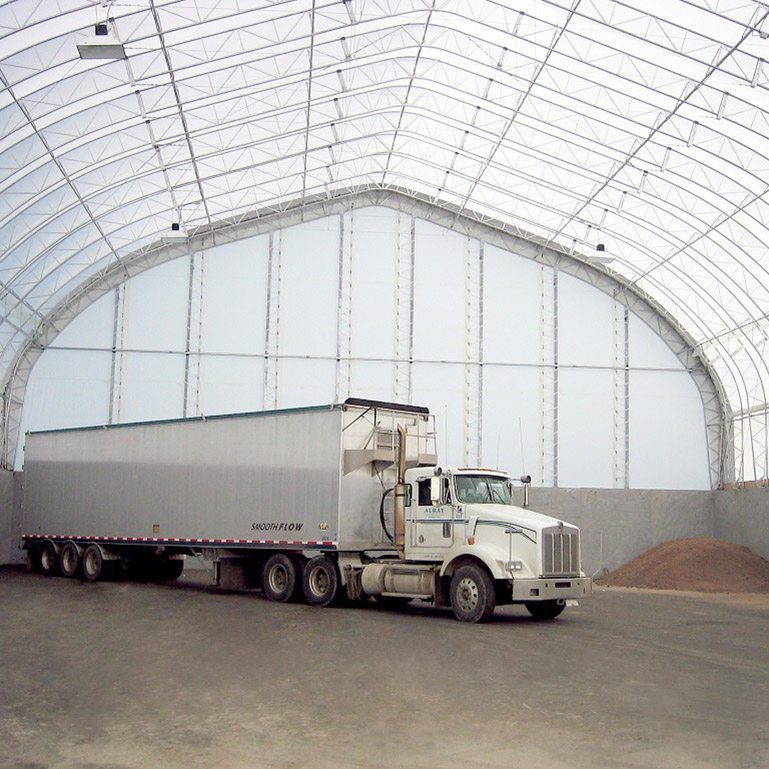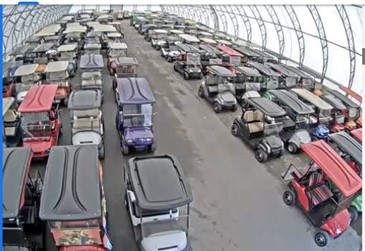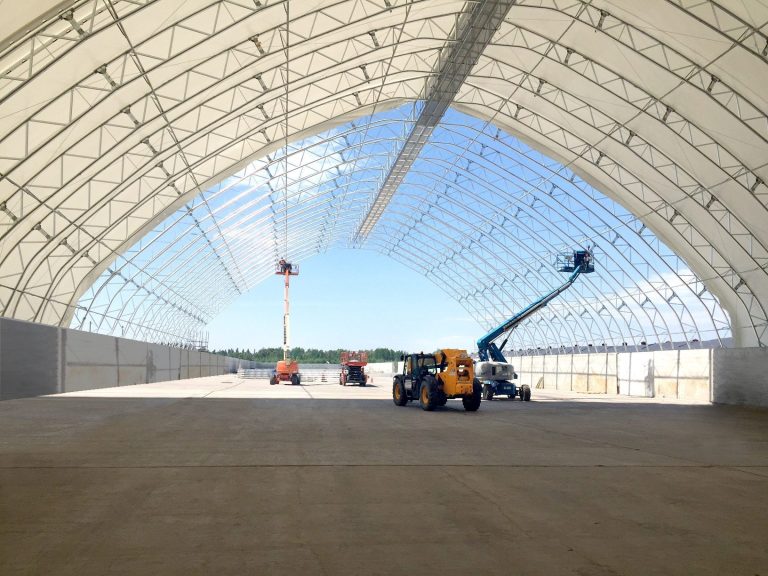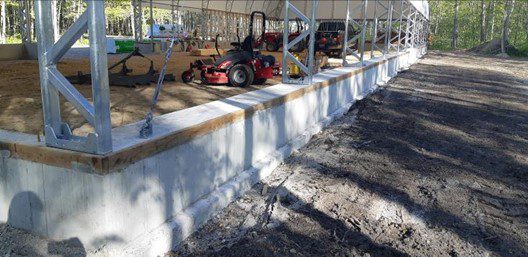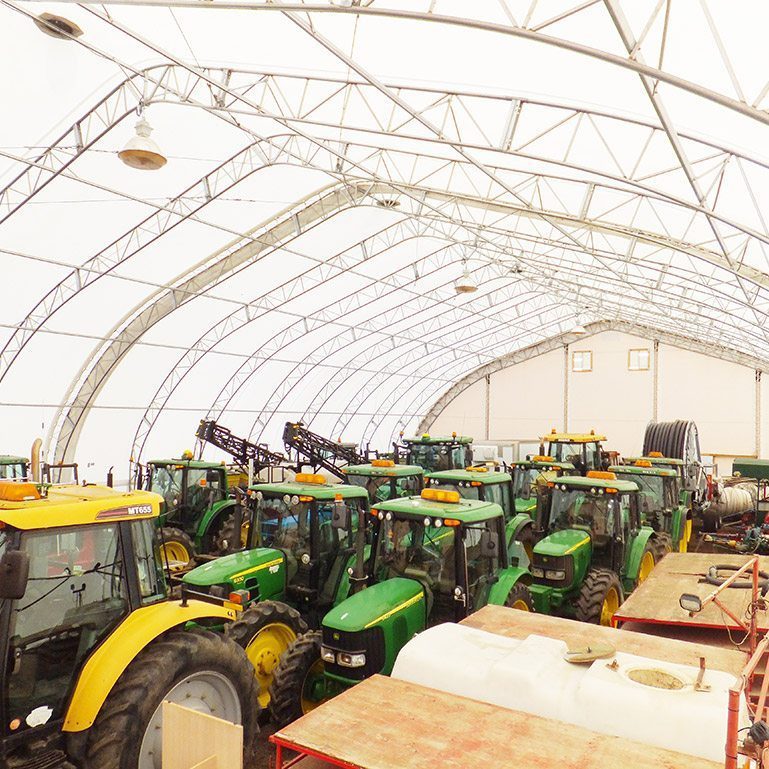Buying A Shelter
When buying a shelter, start by calculating how much space you actually need. Measure the footprint of each of your vehicles, hay bales, etc. and do a preliminary total space estimate. Vehicle storage will take up more space if you plan to work on the vehicles while parked in the building. Parked vehicles may take up more space if you need to shift vehicles around to move some, but not all of them, in and out of the shelter.
Fabric covered buildings range from in size from a one car garage to a small aircraft hangar. Their use is determined more by what the property owner needs and can afford than by the size limitations of the building itself. Typically, these buildings are solutions to a wide variety of storage problems. They can store vehicles, farm equipment, hay, animal feed & bulk materials such as salt or gypsum. They can be large enough for a riding arena, highway trailer storage or even a dispatch depot.
Height
Shelter heights will vary. Three height measurements are important:
- Sidewall height: i.e. the distance from the ground to where the walls begin to curve in toward the roof. Sometimes called the shoulders of the structure. If you plan to store goods on pallets, for example, having high sidewalls will allow you to maximize storage.
- Roof centre line height: i.e. the distance from the ground to the highest point of the roof. This measurement will indicate the cubic capacity of the building and will favour storage of bulk materials.
- Overhead door height: i.e. the distance from the ground to the bottom of the door through which vehicles will pass. This determines the height of vehicles that may enter the fabric building for equipment storage.
Before ordering a shelter make sure that your equipment will fit comfortably through the overhead door and under at least half of the shelter width.
Foundations:
All three measurements can be increased depending on what type of foundation the building will sit on:
- In ground posts
- Grade beam
- Above ground concrete blocks
- Shipping containers
The last two foundations can raise the height of the fabric building from two feet to 10 feet.
One customer asked us to build his shelters on 3’ concrete blocks for added height for highway trailers. It was a simple solution.
Doors
Don’t forget the openings. Vehicle door height is lower than the highest point of the shelter. This limits access. Roll up doors are normally standard equipment but may not be as handy as a barn style sliding door or overhead garage doors. Both of these require some customization that must be designed into the building.
Do you need a man door? Wooden frame or steel frame?
Placement
Location Size. The size of the shelter may determine where you can place it. Avoid overhead wires, tree branches or other overhead obstructions. Allow at least 10 feet on either side of the shelter to provide space to pull the cover up on one side and down on the other.
Level Land. Is the intended shelter space flat? If not, how will you level it? Is the area well drained? Will rain or snow melt flow away from the building?
Foundation.
How will you anchor the shelter in place? You have 4 main choices for a larger permanent structure:
- In ground-above ground poured concrete
- Inground concrete posts
- Above ground concrete blocks, 2’x2’x5’
- Shipping containers
Some companies may offer in ground wooden post anchorage. Avoid this.
If your building is smaller, (30’ or 35’ wide), and temporary you can secure the shelter with steel rods. These are secure, easily installed and removed.
Municipal restrictions:
Confirm with the municipality where the shelter will be erected that a building permit will not be required. This will depend on the temporary nature and purpose of the shelter. For example, will the shelter be used at a construction site for the duration of the construction? If the municipality agrees that your shelter is truly a temporary structure a building permit may not be required. However, after two years the municipality will not be so flexible and you may be forced to remove the building.
To apply for a building permit you must supply drawings of the shelter stamped by a qualified engineer. These are normally supplied by the shelter manufacturer. ASK FOR THESE DRAWINGS BEFORE YOU BUY THE SHELTER. IF DRAWINGS ARE NOT AVAILABLE, DON’T BUY THE SHELTER. You are probably looking at a shelter made in Asia that will not withstand our weather. There is a reason why these off-shore shelters are cheaper than those made here.
Don’t be tempted. Even if your property seems out of the way you may think that a municipal building inspector will never see your not-so-temporary new shelter. Don’t fool yourself. Google Earth offers a service to municipalities to track new construction. This compares new builds to building permits on file. You will be caught.
How Long will your Shelter Last?
The life of a shelter depends on it’s ability to resist exposure to sun, wind and snow. Critical to that resistance are:
- the quality of the material of the cover
- the steel in the frame
- the design & assembly of the shelter
The Cover:
North American made shelter covers are typically made from woven polymer thread. They are designed to be waterproof, wind and ice resistant. When comparing shelters ask specifically about the weight of the weave of the cover.
The Steel:
There are different grades of steel used in any structure and this holds true for fabric covered buildings as well. Look for building frames made from structural steel that has been galvanized using a molten zinc hot dip to protect components from rust. Look for hardware made from zinc nickel or pre-galvanized steel. Look for cables made from stainless steel.
The shape of the metal spars is just as important. The strongest shape is oval. Weaker are square of round tubes.
Design & Assembly
It’s easy to forget that fabric covered buildings are just that: a steel frame covered by fabric. To shed water or ice and snow the fabric must be stretched over the frame so that water cannot rest in any creases or wrinkles. This is critical.
Tension in the fabric is created by straps pulled tight and secured to either the frame or the foundation. If there are not enough straps on the cover, or if the straps are not adequately tightened, water can accumulate, freeze, trap snow and ruin the cover. Before buying a shelter inspect other shelters made by the manufacturer you are investigating. Their covers should be smooth and wrinkle free. It should be obvious that there are enough straps to tighten the cover everywhere and that the straps have been properly tensioned.
The Warranty:
Your shelter should come with a written warranty of at least 15 years on the cover and the structure. Ask for a copy of the warranty before you sign a purchase order.
